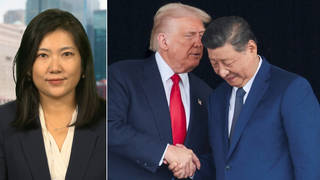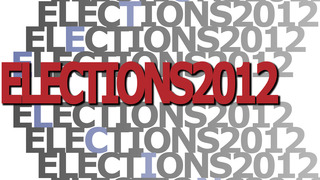
The Obama administration is facing scrutiny following the failure of a solar energy company that received half a billion dollars in government aid and then went bankrupt, laying off about a thousand workers. Newly disclosed internal White House emails show just 60 days after Obama took office, his administration rushed to approve a $535 million loan guarantee to the solar panel manufacturing company Solyndra, despite warnings from the Office of Management and Budget that the loan had not been properly vetted. The White House had advocated Solyndra receive the loan as part of Obama’s stimulus package in order to create green jobs and assist American solar panel manufacturers competing with heavily subsidized Chinese counterparts. Republican opponents of green jobs initiatives could attempt to highlight the firm’s collapse during the upcoming elections. We speak with Joe Stephens, the Washington Post investigative reporter who broke the story. “There are people who are critical of green jobs overall and think they don’t really work, especially at this time during a recession,” Stephens says. “Solyndra might become a household name during the presidential campaign.” [includes rush transcript]
Transcript
JUAN GONZALEZ: The Obama administration is facing scrutiny following the failure of a solar energy company that received half a billion dollars in government aid and then when bankrupt, laying off about a thousand workers. The company was part of the administration’s green jobs initiative, and Obama visited the company’s California facility last year.
Newly disclosed emails show the White House rushed to approve a $535 million loan guarantee to the solar panel manufacturing company Solyndra, despite warnings from the Office of Management and Budget that the loan had not been properly vetted. The firm recently collapsed. Solyndra executives canceled their appearance before a congressional investigative committee earlier this week. The company said in a statement that its executives were busy with the bankruptcy and were discussing a new hearing date with the committee.
Members of the House Energy and Commerce Committee heard testimony Wednesday from administration officials about the government’s loans to Solyndra. Oversight and Investigations Chairman Cliff Stearns said the Department of Energy and the Office of Management and Budget may not have had enough time to adequately review Solyndra because of the pressure to disperse stimulus funds.
CLIFF STEARNS: The documents demonstrate that when DOE was reviewing the Solyndra guarantee in 2009, it was well aware of the financial problems the deal posed. What the documents also show is that the rush to push out stimulus dollars may have impacted the depth and quality of DOE and OMB’s review. In fact, the White House has scheduled Vice President Biden and Secretary Chu’s appearing at Solyndra’s groundbreaking event prior to DOE even making its final presentation to OMB on the terms of the Solyndra deal.
AMY GOODMAN: That was Oversight and Investigations Chair Cliff Stearns.
Republicans say politics may have played a role. Investment funds linked to Tulsa billionaire and top President Obama fundraiser George Kaiser were the lead investors in Solyndra’s operations.
Well, to find out more about this story, we’re going to Washington, D.C., to the offices of the Washington Post to talk to Joe Stephens, the investigative journalist at the paper who broke the story of internal White House emails on Solyndra.
Joe, welcome to Democracy Now! Lay out what it is that you found.
JOE STEPHENS: Well, what we found is Solyndra had been the centerpiece of the Obama administration’s push for clean technology. It had been a centerpiece of the push to create jobs under the stimulus program. And it had been a really favored company. President Obama himself had gone out to stand on the floor of the new factory, built with taxpayer dollars, and say, “The future is here,” and to praise the company for plans to create a thousand jobs. So it was a total shock when, two weeks ago, Solyndra, which had said that its finances were getting better and better, suddenly just collapsed. They closed their doors. They filed for bankruptcy protection, set everyone off in a scramble. A week later, out of the blue, the FBI raided the offices—no prior warning. Now, we had done a big take-out on this company back in June, examining some of these questions. The administration says there was no favoritism, they were really behind this company, they thought it had a bright future. And they think that getting America off dependence on foreign oil, getting—reducing greenhouse gases and creating jobs, these are all very important. So, this was a shock.
Now, what we found out a week ago is, at the Post, we got a hold of internal White House emails. And the emails show that on the eve of approval of this loan, half a billion dollars, the very first one to go out the door, went out the door—it was approved 60 days after Obama took office—that while this was being scored, they were trying to decide—doing their due diligence to decide is this a good deal, a good risk—that there was a lot internal email traffic in the White House with pressure, saying, “The Vice President wants to appear at the groundbreaking for this new factory. Please get your review done as quickly as possible.” Within the Office of Management and Budget, the people who were actually scoring the risk, there was traffic back and forth saying, “This is a problem. We need to do our due diligence. We don’t want to be rushed. We don’t want to be driven by PR events.” Now, what we don’t know is if this pressure actually affected the review at all. The administration says no. They just wanted to know the timing; they didn’t want to press for a favorable result.
JUAN GONZALEZ: Now, there is the issue, of course, that one of the major investors, George Kaiser, not only is close—is a fundraiser for the President, but apparently visited the White House about 16 times. I would assume, though it’s hard to say, that on one of those visits he may have talked, at one point or another, about his investment in Solyndra. But there’s no indication that there was any pressure from the White House or any pressure by Kaiser on the White House to get this thing approved?
JOE STEPHENS: Well, right. When you look at the White House logs, George Kaiser has been a regular, frequent visitor. And some of these visits coincided with key events in Solyndra’s history, when they were hitting milestones and needed to get money for this or that to continue operating. Now, of course, we’re not at those meetings. We don’t know what occurred. The logs list meetings with the staff of Valerie Jarrett, of Rahm Emanuel, very top people, but George Kaiser, who has not sat down for an interview with us, he says, through a spokesman, that he did not bring up Solyndra, he did not use political influence. Now, the ties are clear. He raised a lot of money for Obama’s presidential campaign. He hosted a fundraiser in his home in Tulsa that the President attended. So, he had access. Did he use that access for Solyndra? He says no. We don’t know anything otherwise now. The House Energy and Commerce Committee is investigating. There may be more found out down the line.
AMY GOODMAN: Let’s go to President Obama in May of last year, when he visited the Solyndra plant and laid out his vision for a clean energy future, touting the future impact that Solyndra could have on the U.S. economy.
PRESIDENT BARACK OBAMA: Fifteen years ago, the United States produced 40 percent of the world’s solar panels, 40 percent. That was just 15 years ago. By 2008, our share had fallen to just over five percent. I don’t know about you, but I’m not prepared to cede American leadership in this industry, as I’m not prepared to cede the America’s leadership in the global economy. So that’s why we’ve placed a big emphasis on clean energy. It’s the right thing to do with our—for our environment. It’s the right thing to do for our national security. But it’s also the right thing to do for our economy.
And we can see the positive impacts right here at Solyndra. Less than a year ago, we were standing on what was an empty lot. But through the Recovery Act, this company received a loan to expand its operations. This new factory is the result of those loans. Since the project broke ground last fall, more than 3,000 construction workers have been employed building this plant. Across the country, workers—across the country, workers in 22 states are manufacturing the supplies for this project. Workers in a dozen states are building the advanced manufacturing equipment that will power this new facility. When it’s completed in a few months, Solyndra expects to hire a thousand workers to manufacture solar panels and sell them across America and around the world. And this, in turn, will generate business for companies throughout our country who will create jobs supplying this factory with parts and materials. So there’s a ripple effect. It’s not just localized to this area.
AMY GOODMAN: That was President Obama at the Solyndra plant. Joe Stephens is one of the reporters who broke the story in the Washington Post of the email going back and forth between the White House and the Office of Management and Budget, OMB very concerned about the speed with which these loan guarantees were being approved. Joe Stephens, why did Solyndra go down? Why did it collapse several weeks ago?
JOE STEPHENS: Well, we don’t know all the details. They got half a billion dollars from federal taxpayers. They had about a billion dollars, in addition, in private capital. So, a total of $1.5 billion. Some people have said, “How can you possibly burn through that much money?”
Now, they had a new technology. They were trying to make a new kind of solar panel, which actually was more expensive to make and it was less efficient than your standard solar panel, so that’s a challenge. Now, the key was that this was much easier to install. Amy, you and I could take these things and plug them in like Legos on a roof, and they would work. That was the real attraction: they were cheap and easy to install.
Now, while they were gearing up, getting their technology on how to make these panels, meanwhile it became kind of an arms race in the solar panel industry. And China has gone in in a big way, with very heavy subsidies, and they’re making traditional panels much, much cheaper than Solyndra could make them. And this all happened while they were gearing up, whether building a factory, getting their manufacturing processes down. And there’s also—there’s been a shakeout in the solar industry. There have been other American solar companies that have failed or moved their operations to China. So it’s gotten very cutthroat, very competitive.
Now, bottom line, we don’t know. They’re in bankruptcy court now. There will be a lot of financial information coming out. We do know they had had problems. They wanted to go public, have an initial public offering a year or so ago. And they pulled out of that at the last minute. Auditors said they didn’t have the cash flow. And we also know—they came near collapse a couple other times, it’s now coming out. Back at the end of last year, they had a liquidity crisis. The Department of Energy came in, and they refinanced their loan. And actually, this could now cost us taxpayers $100 million more or so, because we kind of doubled down. The Department of Energy didn’t want them to go under then. They jumped in and gave them more money.
And we’ve got a story in the Post today talking about, internally in the OMB, more email traffic, people saying at the time, “This could be a really big political hit to the President if this company goes down. And the hit might actually be smaller if we let the company collapse in January, whereas propping them up, if it comes later, it could be more damaging as the presidential campaign is heating up.” And that’s the situation, it looks like, we actually have now.
JUAN GONZALEZ: Well, Joe Stephens, like anything in Washington, this becomes part of the partisan political warfare there. Obviously, it’s a House Republican Committee that’s leading the investigation, and some are looking at this as an attempt to basically blast green jobs or green technology, overall. Could you talk about that and how this is playing out in Washington?
JOE STEPHENS: There absolutely is an element of that, that there are people who are critical of green jobs, overall, think they’re a boondoggle, don’t really work, especially at this time, during a recession, it’s the wrong time to put money into this. And this obviously is just fuel to their fire, and they’re ready to go to the barricades on that. There are other people who say they are not, definitely not, anti-green job. The people running the House investigation, Republicans, say they are not anti-green jobs; they just want the money to be well spent and say they’re trying to do a conscientious job on this.
Now, clearly, it’s partisan. I think this will be brought up again and again. Solyndra might become a household name during the presidential campaign, because it—what can you do? You’ve got the video of the President at the factory. You’ve got him saying, “The future is here. These are jobs.” This was—you know, they really put all their chips on this. This was the first company they backed. You would think it was the best chance they had for success, and it went under. So if it went under, what about the other companies that have come later and the ones that are still in the pipeline? So, this really opens him up to political bickering. But there are some—also some very serious questions that need to be answered, too.
AMY GOODMAN: Will it be used to say solar is doomed, Joe?
JOE STEPHENS: I’m sure it will be used to say that. Now, whether that’s an effective argument or not, I don’t know. This is a particular situation, it’s a particular company. They had a new, cutting-edge thing they were trying to do. Their solar panels don’t look like—they’re not flat. They look like an array of fluorescent lights that you drop on your roof. Now, that technology may or may not be dead, but it doesn’t mean the whole solar industry is dead. What we are saying is there’s heavy competition from China, and China wants to own this industry. And that’s a different issue, whether there are jobs to be created here in the solar industry.
AMY GOODMAN: Joe Stephens, we want to thank you very much for joining us, investigative reporter for the Washington Post, where he’s joining us from in Washington, D.C. He broke the story, with his colleagues, of the internal White House emails on Solyndra.












Media Options